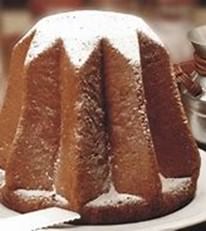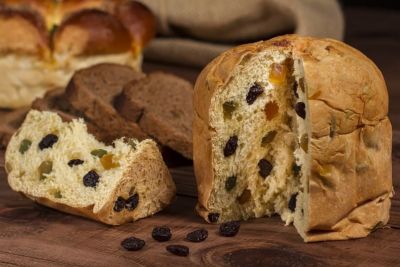Every year Christmas comes with the same question: should we celebrate Christmas by eating Panettone or Pandoro? This is one of the recurring questions during the Christmas season. In Italy, there are those who love Panettone and those who prefer Pandoro.
In reality, both Christmas desserts are good, but they have completely different histories. Panettone has an ancient history, dating back to the period of the Sforza family of Milan, under the famous Ludovico Sforza, nicknamed Ludovico il Moro, who ruled around the year 1495. Like every story about a famous and typical Italian recipe, Panettone was born by a mistake. It is said that during Christmas Eve in the court of Ludovico il Moro, everyone in the kitchen was busy preparing and organizing the various dishes for a banquet to be held later that night. The head chef decided to entrust his young helper, Toni, with the responsibility of preparing the dessert that would be served at the end of the banquet. The boy fell asleep while doing so, burning the dessert. Fearing what would happen to him, he proposed to the head chef his recipe which would use the leftover dough from another dish. He took the leftover bread dough, and he added butter, eggs, raisins, and candied fruits to the dough. In a few minutes the sweet smell of the dessert filled the room, and the head chef took a chance to serve this bread because it smelled so good.
The first person to try the sweet bread was the duchess, who closed her eyes as she tried it, and she yelled “THE BEST!” The duke was also impressed. In just a few days, word spread all over Milan that this sweet bread, called “il pan di Toni” (Toni’s bread), was served at the banquet. This was the original name for this dessert until it later just became known as Panettone.
There are different renditions about the origins of Pandoro. The oldest of these stories comes from ancient Rome during the first century AD, when Plinio the Old praised Chef Senex’s delicacies. Plinio spoke about the recipe for “Panis,” which was a dessert made from butter, flour, and oil.
Other renditions of Pandoro’s origin says it was born in the year 500 in Venice and was called “Pan de oro” by the Venetians. It was made with flour, sugar, and butter. It was Domenico Melegatti, though, who got a patent for his Pandora from Verona Melegatti. He said he got inspiration from an old Veronese Christmas tradition, when women from Verona used to gather together to make a dessert called “Leva.” This dessert was made from flour and eggs and covered with a lot of sugar.
Whichever you choose to eat, whether it is Panettone or Pandoro, will be a good choice. They are both delicious and optimal ways to finish your big Christmas Eve dinner as well as your Christmas day lunch.
With that, I wish you a tranquil and Merry Christmas.
Ogni anno che arriva il Natale si ripete sempre la stessa domanda: Si festeggerà la notte di Natale mangiando il Panettone o il Pandoro? Si perché questa è una delle domande più ricorrenti durante le festività Natalizie, in Italia infatti, ci sono gli amanti del Panettone e quelli del Pandoro.
In realtà tutti e due i dolci tipici del Natale sono buoni ma hanno due storie completamente diverse. Sicuramente il Panettone ha una storia molto antica risalente al periodo degli Sforza padroni di Milano, siamo sotto il dominio del famoso Ludovico Sforza famoso con il nome di Ludovico il Moro e ci troviamo all’incirca nell’anno 1495. Come ogni storia dei piatti tipici e famosi della cucina italiana, anche il Panettone nasce per un errore. Si narra infatti che durante la vigilia di Natale alla corte di Ludovico il Moro, tutta la cucina è impegnata a preparare e organizzare le varie portante del banchetto che si terra di lì a poco. Il capo cuoco decide di affidare al suo aiutante giovane Toni, la responsabilità di controllare la cottura del dolce che verrà servito a fine banchetto. Il povero ragazzo stanco si addormenta, facendo così bruciare il dolce. Con la paura che possa accadergli qualcosa di brutto, il giovane, propone al capo cuoco una sua ricetta che serve a recuperare gli avanzi dell’impasto delle ciambelle. A questi avanzi di pasta di ciambelle aggiunge il burro, le uova, l’uvetta e i canditi. In pochi minuti la cucina si riempie di odore del dolce e il capo cuoco catturato dal profumo decide di rischiare e servire il dolce. La prima persona a provare il dolce sarà la Duchessa che, chiudendo gli occhi nell’assaggiarlo, emetterà la parola OTTIMO! Il Duca anche si dichiara estasiato. In pochi giorni in tutta Milano si diffonde la notizia che al banchetto a fine pasto è stato servito “Il pan di Toni” questo è il primo nome del panettone che cambierà il nome fino a divenire famoso con il nome di Panettone.
Il Pandoro ha diverse storie sulla sua origine. La più antica risale all’antica Roma al primo secolo dopo Cristo, quando Plinio il Vecchio decantando le prelibatezze preparate dal cuoco Senex, parla della ricetta del “Panis” un dolce a base di burro, farina e olio. Altri dichiarano che il Pandoro sia nato intorno al ‘500 a Venezia, chiamato dai Veneziani “Pan de oro”, composto da farina, zucchero e burro. Domenico Melegatti però è stato l’unico a presentare il brevetto del Pandoro di Verona Melegatti, che prende ispirazione dall’antica tradizione Veronese. Durante il periodo natalizio, infatti, le donne di Verona si radunavano per preparare un dolce dal nome “Leva’” composto da farina e uova e ricoperto da tanto zucchero.
Comunque sceglierete, che si tratti di Panettone o di Pandoro, come si dice: “Cadrete bene” perché sono tutti e due ottimi dolci per finire il vostro cenone di vigilia o per concludere il vostro pranzo di Natale. Quindi mi resta solo di augurarvi un Sereno e Felice Natale!

Il Pandoro



